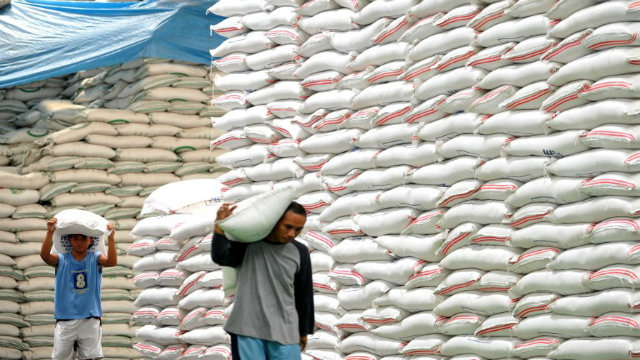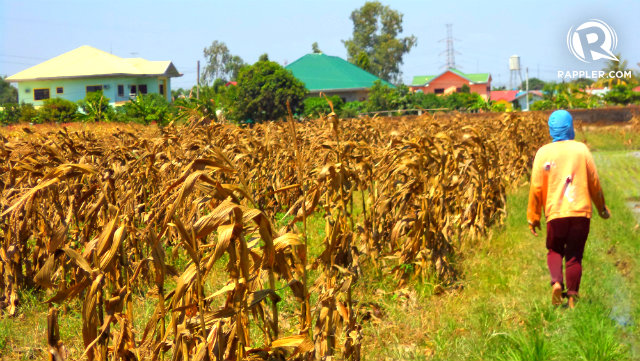SUMMARY
This is AI generated summarization, which may have errors. For context, always refer to the full article.

MANILA, Philippines – The Philippines can do a whole lot more in addressing hunger through food self-sufficiency. (READ: Why is PH agriculture important?)
But how come the Philippines, an agricultural country, is not yet rice self-sufficient? (READ: Who’s afraid of food insecurity?)
“Sufficient tayo kung rice lang, pero there is 12.66 MMT (million metric tons) na kailangan pang i-produce kasi ‘di lang naman food ang allocation for rice; there are rice crackers, feeds, rice processing, etc,” Hazel Tanchuling, Secretariat Coordinator of the Rice Watch and Action Network, explained.
(We’re sufficient in terms of rice, but there’s still a need to produce 12.66 MMT because food is not the only allocation for rice.)
Self-sufficiency in food staples means that the country must produce the national food requirement while also maintaining a buffer stock to be used in times of need, according to the Philippine Rice Research Institute (Philrice).
The country’s area harvested to rice is very small compared to major rice producing Asian countries, the Pinoy Rice Knowledge Bank of the Department of Agriculture (DA) reported. “Although we say that we are an agricultural country, we don’t have large land resources to produce our total rice requirement.” (READ: PH food wastage)
The Philippines, despite being the 8th largest rice producer in 2008 (16.8 million tons), was also the world’s top rice importer (1.8 million tons), the World Rice Statistics and the Food and Agriculture Organization reported.
|
Rice output from the produced palay |
||
|
Year |
Palay Production (in metric tons) |
Rice output (in metric tons) |
|
2010 |
15.77 M |
9.46 M |
|
2011 |
16.68 M |
10 M |
|
2012 |
18.03 M |
11.06 M |
|
2013 |
18.44 M |
11.30 M |
(Source:Bureau of Agricultural Statistics)
For this year, DA is targeting to produce 19.32 MMT of palay or a 4% increase from 2013. With an average milling recovery of 60%, rice output is an estimated 11.59 MMT.
Pinoy rice consumption
Though the Philippines increased its rice production, it still wasn’t enough to provide for our rice consumption requirement. (READ: NFA: Rice prices to go up during lean months)
| Rice Consumption per capita | |
| Year | Kg |
| 1990 | 92.53 |
| 1995 | 92.55 |
| 2000 | 103.16 |
| 2005 | 110.0 |
| 2010 | 114.81 |
| 2012 | 117.14 |
(Source: Bureau of Agricultural Statistics)
The Philippines has had a 27% increase in rice consumption since 1990. (READ: PH rice smuggling)
The country’s growing rice consumption requirement is parallel to the growing population. (INFOGRAPHIC: How much rice do Filipinos consume?)
“The production is increasing historically and generally because before we didn’t raise hybrid rice. Hybrid seeds only began in 2005. But in 1998, there was an El Niño, so production dropped. In 2009, there was Typhoon Ondoy (Ketsana) so production was also low,” Jacinta Estrada, Bureau of Agricultural Statistics (BAS) statistician, explained. (READ: Typhoons slow down PH agri)
With the average milling recovery going from 60% to 65%, rice produced in the country is still almost insufficient for the growing population. (READ: What is ‘golden rice’?)
|
Trend of Philippine milled rice production and the population |
||||||
|
|
1970 |
1980 |
1990 |
2000 |
2010 |
2013 |
|
Milled rice production |
3.4 M |
5.02 M |
6.43 M |
8.14 M |
10.54 M |
11.64 M |
|
Population |
36.7 |
48.1 |
60.7 |
76.5 |
92.33 |
97.7 |
(Sources: * United States Department of Agriculture, ** National Statistics Office)
The Philippines achieved rice self-sufficiency in the 1970s and even exported small quantities of rice in the early 1980s because of the “Green Revolution” which included improvements in irrigation, varieties, and fertilizers. (READ: Gov’t prepares PH agri for El Niño)
“There were massive losses in milling because milling was inefficient. It could have still increased 40%-45%. The percentage of loss depends on machines; infrastructure’s also a big factor. Most of the milling facilities now are column type, the small ones, with lots of losses,” Tanchuling said. (READ: PH farm-to-market roads)
The country’s rice self-sufficiency since 1990 has been increasing, but dropped since the early to mid-2000s. The world rice crisis in 2007 and 2008 also affected the country’s self-sufficiency since we were one of the biggest importers.
The DA recently adopted a new formula for a more accurate Rice Self-Sufficiency (RSS) ratio. (READ: PH female farmers, invisible food producers)
With the new formula, the DA declared 98% rice self-sufficiency ratio for the year 2012. This is the latest RSS that the Department has released so far. (READ: Farmers need more government support)
What can be done?

“81% of the increase in area harvested from 2000-2010 was due to expansion of irrigated areas, while 19% on non-irrigated ecosystems,” PhilRice said. 73% of the production increase also came from irrigated areas. (READ: Climate change and food insecurity)
“With the government’s target of more than P100-million worth of irrigation budget to be given by 2016, there will be hopefully significant increase in irrigation cover,” Tanchuling added. (READ: COA hits NIA for poor irrigation record)
The DA IQ 2014 Agri report stated that the Department already allotted P1.61 billion for El Niño mitigation schemes, from which a bulk of more than P500 million will be allotted for the provision of seeds, planting materials, and other production inputs. (READ: Strengthening ASEAN agriculture)
There are many ways the government could still make rice self-sufficiency a more attainable goal for the Philippines. Tanchuling cited some suggestions:
- Diversification: Multiple strategies to improve production and market competitiveness, lower production cost from P11 to P7 just like in Thailand
- Subsidize service irrigation fees of farmers
- Promote community production of different types of seeds which are locally adapted to soil and climate condition
- System of Rice Intensification which uses less water and less seeds
- Ecological pest management to alleviate use of fertilizers and pesticides
- Better credit program for the farmers: Our credit interest is 20-40%; in other countries, it’s only 4-5%
- Greater insurance coverage: The 2013 budget covered only less than 10 % of the penetration coverage
- Palay procurement: Part of the produce should be bought by the government at a higher price
“Milling, infrastructure, enhancing the total farmer productivity, increased budget for agricultural research and processes, tighter measures against smuggling – these can help pave the way towards rice self-sufficiency of the country,” Tanchuling concluded. – Rappler.com
Allison Danao is a Communications student at the University of the Philippines Los Baños and a Rappler intern.
Add a comment
How does this make you feel?
There are no comments yet. Add your comment to start the conversation.